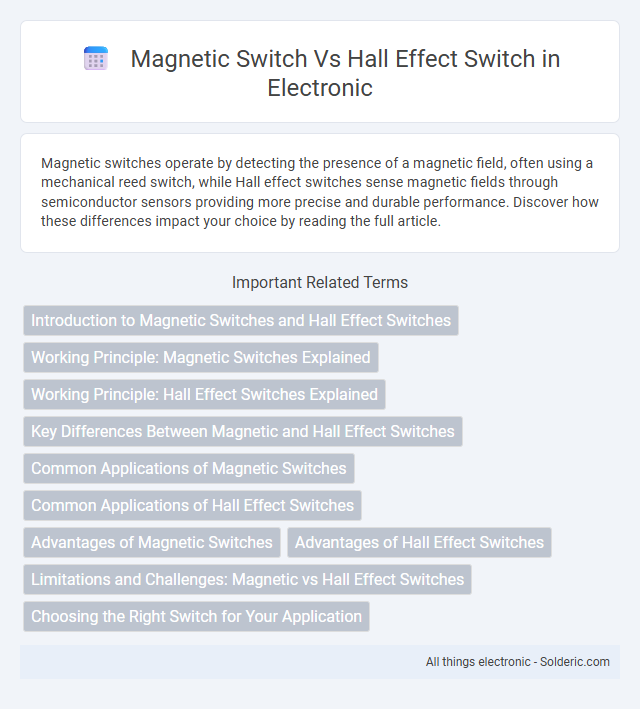Magnetic switches operate by detecting the presence of a magnetic field, often using a mechanical reed switch, while Hall effect switches sense magnetic fields through semiconductor sensors providing more precise and durable performance. Discover how these differences impact your choice by reading the full article.
Comparison Table
| Feature | Magnetic Switch | Hall Effect Switch |
|---|---|---|
| Operating Principle | Uses a magnetic reed or contact that closes in presence of a magnetic field | Detects magnetic fields via semiconductor sensor, producing electronic output |
| Sensitivity | Moderate; depends on magnet strength and switch gap | High; detects small changes in magnetic fields precisely |
| Durability | Mechanical parts prone to wear and tear | Solid-state; longer lifespan, no mechanical wear |
| Output Type | Mechanical contact (Normally Open or Normally Closed) | Digital or analog electronic output |
| Response Time | Slower due to mechanical movement | Fast electronic switching |
| Power Consumption | None or very low (passive) | Requires power supply (typically 3.3V to 24V) |
| Environmental Resistance | Vulnerable to mechanical shock and vibration | Better resistance to shock, vibration, and extreme temperatures |
| Applications | Door sensors, alarms, industrial limit switches | Position sensing, speed detection, brushless DC motors |
| Cost | Generally lower cost | Higher cost due to semiconductor technology |
Introduction to Magnetic Switches and Hall Effect Switches
Magnetic switches operate by detecting changes in a magnetic field using reed contacts that open or close circuits, making them ideal for simple on/off applications. Hall effect switches utilize the Hall sensor principle to measure the strength and polarity of a magnetic field, providing precise and non-contact detection with higher reliability and durability. Understanding the differences between these switches helps you choose the best solution for sensing position, speed, or proximity in your electronic projects.
Working Principle: Magnetic Switches Explained
Magnetic switches operate by detecting the presence or absence of a magnetic field to open or close an electrical circuit, relying on components like reed switches that physically move in response to magnetic attraction. Hall effect switches use a semiconductor sensor that generates a voltage proportional to the magnetic field strength, enabling contactless switching with higher durability and faster response times. Understanding these working principles helps you choose the ideal switch based on sensitivity, reliability, and application requirements.
Working Principle: Hall Effect Switches Explained
Hall effect switches operate based on the Hall effect principle, where a magnetic field applied perpendicular to a current-carrying conductor generates a voltage difference across the conductor. Unlike magnetic switches that rely on physical movement or contact changes triggered by a magnet, Hall effect switches detect changes in magnetic flux density to produce a reliable electronic signal. This solid-state sensing mechanism ensures higher durability, precision, and faster response times in applications requiring non-contact magnetic detection.
Key Differences Between Magnetic and Hall Effect Switches
Magnetic switches rely on a physical reed or contact mechanism activated by an external magnetic field, while Hall effect switches use a semiconductor sensor to detect changes in magnetic flux density without mechanical movement. Hall effect switches offer higher durability and faster response times, making them suitable for environments requiring reliable, non-contact sensing. Your choice depends on factors such as sensitivity, lifespan, and environmental conditions, with Hall effect sensors providing better performance in precision and harsh settings.
Common Applications of Magnetic Switches
Magnetic switches, including reed switches and proximity sensors, are widely used in security systems for door and window monitoring to detect open or closed states. They are also common in industrial automation for position sensing and machinery control, providing reliable contactless activation. Furthermore, magnetic switches are integral to consumer electronics, such as smart appliances and wearable devices, where they enable power saving and operational safety.
Common Applications of Hall Effect Switches
Hall effect switches are widely used in automotive systems for position sensing, such as detecting crankshaft or camshaft positions. These sensors are also common in consumer electronics and industrial automation for proximity detection and speed measurement, providing non-contact, wear-free operation. Your projects benefit from the reliability and precision of Hall effect switches in environments with dirt, dust, or oil where magnetic switches may fail.
Advantages of Magnetic Switches
Magnetic switches offer robust durability and reliability in harsh environments due to their simple mechanical design with fewer electronic components, reducing failure rates. They provide cost-effective solutions for detecting the presence or absence of magnetic fields without requiring power for operation, making them ideal for low-energy applications. Their ability to operate in extreme temperatures and resist electromagnetic interference enhances performance in industrial and automotive settings.
Advantages of Hall Effect Switches
Hall Effect switches offer precise and reliable magnetic field detection with no physical contact, ensuring longer durability and reduced wear compared to magnetic switches. They provide faster response times and greater sensitivity to variable magnetic field strengths, enabling accurate position sensing and speed measurement in diverse applications. Your choice of a Hall Effect switch benefits from immunity to dust, dirt, and moisture, enhancing performance in harsh environments.
Limitations and Challenges: Magnetic vs Hall Effect Switches
Magnetic switches often face limitations such as susceptibility to external magnetic interference and reduced accuracy in complex environments, which can lead to false triggering or signal loss. Hall effect switches provide higher precision and immunity to external magnetic noise but require a stable power supply and are generally more complex in circuit design. Both technologies encounter challenges in miniaturization and sensitivity adjustments, impacting their performance in specialized industrial and automotive applications.
Choosing the Right Switch for Your Application
Selecting the right switch for your application depends on factors like sensitivity, durability, and environmental conditions. Magnetic switches, such as reed switches, offer simplicity and cost-efficiency but are susceptible to mechanical wear and limited precision. Hall effect switches provide non-contact operation, higher accuracy, and enhanced reliability in harsh environments, making them ideal for applications requiring consistent performance and longevity.
magnetic switch vs hall effect switch Infographic

 solderic.com
solderic.com